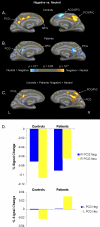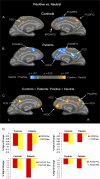Dysfunction of a cortical midline network during emotional appraisals in schizophrenia
- PMID: 19605517
- PMCID: PMC3004194
- DOI: 10.1093/schbul/sbp067
Dysfunction of a cortical midline network during emotional appraisals in schizophrenia
Abstract
A cardinal feature of schizophrenia is the poor comprehension, or misinterpretation, of the emotional meaning of social interactions and events, which can sometimes take the form of a persecutory delusion. It has been shown that the comprehension of the emotional meaning of the social world involves a midline paralimbic cortical network. However, the function of this network during emotional appraisals in patients with schizophrenia is not well understood. In this study, hemodynamic responses were measured in 14 patients with schizophrenia and 18 healthy subjects during the evaluation of descriptions of social situations with negative, positive, and neutral affective valence. The healthy and schizophrenia groups displayed opposite patterns of responses to emotional and neutral social situations within the medial prefrontal and posterior cingulate cortices--healthy participants showed greater activity to the emotional compared to the neutral situations, while patients exhibited greater responses to the neutral compared to the emotional situations. Moreover, the magnitude of the response within bilateral cingulate gyri to the neutral social stimuli predicted delusion severity in the patients with schizophrenia. These findings suggest that impaired functioning of cortical midline structures in schizophrenia may underlie faulty interpretations of social events, contributing to delusion formation.
Figures




References
-
- Aleman A, Kahn RS. Strange feelings: do amygdala abnormalities dysregulate the emotional brain in schizophrenia? Prog Neurobiol. 2005;77:283–298. - PubMed
-
- Pinkham AE, Penn DL, Perkins DO, Lieberman J. Implications for the neural basis of social cognition for the study of schizophrenia. Am J Psychiatry. 2003;160:815–824. - PubMed
-
- Poole JH, Tobias FC, Vinogradov S. The functional relevance of affect recognition errors in schizophrenia. J Int Neuropsychol Soc. 2000;6:649–658. - PubMed
-
- Phillips ML, Drevets WC, Rauch SL, Lane R. Neurobiology of emotion perception II: implications for major psychiatric disorders. Biol Psychiatry. 2003;54:515–528. - PubMed
Publication types
MeSH terms
Grants and funding
LinkOut - more resources
Full Text Sources
Medical

